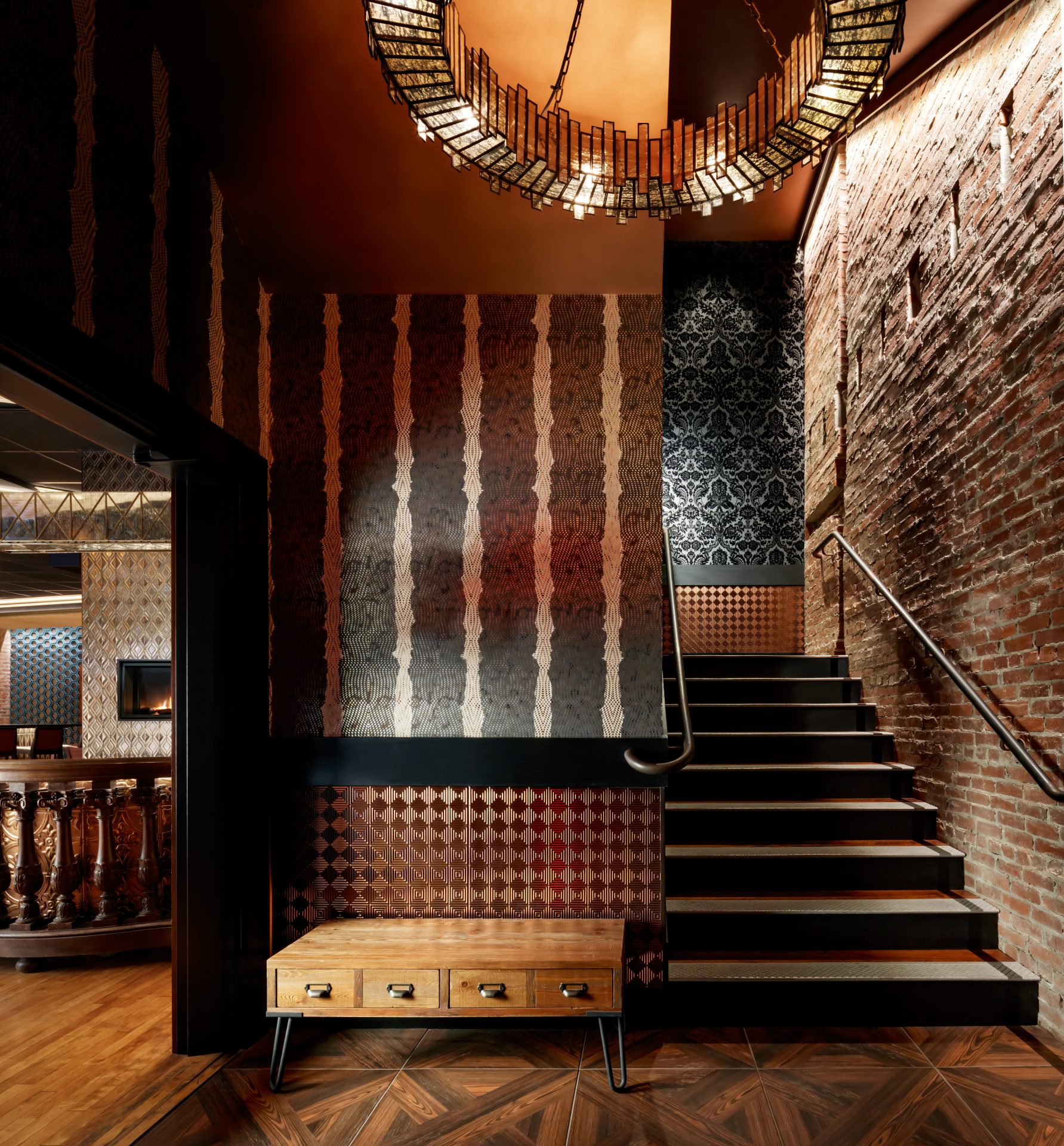Kanù Revitalizing an Old Town With Iconic Restaurant, Bar + Entertainment Design
Ervin Architecture was charged with the exciting opportunity to put Maine’s newest dining and entertainment spot on the map. The design of Kanù pays tribute to Old Town Canoe, a business that was owned and operated by the client’s family for many years. Our team crafted a dynamic and versatile space that encompasses a farm-to-table restaurant on the first floor, a vibrant nightclub on the second floor, and a breathtaking rooftop lounge on the third floor. Kanù is an unforgettable experience for visitors, combining exceptional dining, lively entertainment, and stunning views. This 3-story multi-functional complex reflects our commitment to design excellence and establishes itself as a must-visit destination in Maine.
As part of an adaptive reuse economic initiative in the City of Old Town, Maine and the client’s vision of revitalizing his home town into an Arts & Entertainment District. The project involved transforming a 19th-century brick and timber mercantile building into the anchor tenant for the downtown district. By repurposing the existing building and incorporating historical elements with contemporary aesthetics, Kanù was able to attract visitors to the area, generate new jobs, and add cultural vibrancy.
Location
STYLE
CATEGORY
Restaurants + Bars
Nightclubs
Performance Venues
Services
Architectural Design
Interior Design
Master Planning
Permitting
Lighting Design
Fabrication
PROJECT SIZE

IVY
NIGHTCLUB
The nightclub provides a venue for dancing, live music, and entertainment events, fostering a sense of community and cultural vitality.
THE ROOFTOP
BAR + lOUNGE
The rooftop lounge features comfortable seating, fire pit tables, and panoramic views, creating a relaxing atmosphere for visitors to unwind and enjoy the surroundings.
project COLLABORATIONS
CNC Fabrication
Reclaimed Timber
Architectural Lighting
Masonry
Wood-Fired Oven Surround
Wood-Fired Pizza Oven
Wood-Fired Oven
Wood-Fired Grill
PHOTOGRAPHY
Brandon Barré | Architectural
Darren Setlow | Lifestyle
Inspired Design
In consultation with our architect Ervin Architecture, it was important to use woods throughout the space since wooden canoes were the first canoes my family produced here. Our connections to Old Town Canoe inspired the name KANÙ.
Alex Gray
Owner + Restaurateur
Project story
Before Design
Upon receiving the failing structure, the design team at Ervin Architecture had to shift their focus from conceptual renderings to assessing the existing conditions of the building and understanding its inherent capabilities. They needed to determine what the building could achieve in its current state and identify any necessary repairs or modifications for a reasonably affordable redesign.
The original structure of the building, typical of many 19th-century masonry buildings, was constructed with sturdy materials like reinforced timber floor joists, minimal iron columns, and tongue and groove hardwood floors. These buildings were designed to withstand heavy loads, such as the transportation and distribution of goods. While the buildings had solid structural foundations, they often featured era-specific inexpensive infill construction.
Due to economic stagnation, these buildings had remained largely intact over the years, with minimal alterations or renovations. Thus, the first step in bringing such buildings back to life often involves a complete gut demolition of anything other than the original structure. This process effectively resets the building’s typology and allows the architect to address critical primary components such as egress/ingress, fire separation, structural reinforcement for floor deflection, acoustic considerations, universal/ADA access, and fire suppression.
The architect must prioritize the proper functioning of the building before considering the design elements. As famously stated by Mies Van Der Rohe, “Form Follows Function,” meaning that the building’s design should be determined by its intended purpose and functionality.
The EA design team listened to the building, taking into account code requirements, programmatic requirements, building science relationships, and design elements. They carefully assessed the existing conditions and incorporated necessary modifications to ensure that the building met contemporary standards and regulations. This process involved addressing issues such as safety, accessibility, structural stability, and acoustic performance.
Once the fundamental aspects were addressed, the design team could then focus on incorporating the desired design flavor and creating a space that fulfilled the economic initiative’s goals. By taking a comprehensive and pragmatic approach, the team ensured that the building would be transformed into a functional, safe, and appealing space, capable of attracting people, generating economic growth, and adding cultural vibrancy to Old Town, Maine.
Governing Concepts
In the process of redesigning the building, Ervin Architecture recognized several key governing concepts that took priority. These concepts were identified based on their importance in meeting code requirements and ensuring the safety and functionality of the space.
Two Means of Egress
Providing two separate and distinct means of egress is a fundamental requirement for ensuring occupant safety in case of an emergency. It allows for multiple exit options, reducing the risk of congestion and facilitating a swift evacuation if needed. The design team would have prioritized creating clear and accessible pathways for egress, considering factors such as exit locations, travel distances, and signage.
Fully Sprinklered Building
Installing a comprehensive sprinkler system throughout the building is essential for fire protection. A sprinkler system can quickly suppress and control fires, minimizing property damage and protecting occupants. The design team would have incorporated the necessary infrastructure for a full sprinkler system, including water supply, sprinkler heads, piping, and control valves.
Fire Separation between Floors
To prevent the spread of fire and smoke between different levels of the building, fire separation measures must be implemented. This typically involves constructing fire-rated barriers, such as walls, floors, and doors, that meet the required fire-resistance ratings. The design team would have ensured that proper fire separations were incorporated into the building’s design to enhance fire safety and compartmentalization.
Kitchen Exhaust Requirements
Given the plan to include a restaurant on the first floor, addressing kitchen exhaust requirements was crucial. This involves designing and installing an effective ventilation system that adequately captures and removes smoke, grease, and odors produced during cooking processes. The design team would have considered both conventional cooking environments and areas with grills, ensuring compliance with applicable building codes and regulations.
By prioritizing these code requirements, the design team demonstrated their commitment to creating a safe and compliant space. These concepts ensured that the building would meet the necessary standards for occupancy, allowing it to operate as intended while providing a secure environment for occupants, staff, and visitors.
Primary Programmatic Requirements By Floor
By incorporating these programmatic requirements into each floor, the design team would ensure that the building offers the necessary amenities and spaces to fulfill the envisioned entertainment complex concept. These spaces would attract visitors, provide a range of experiences, and contribute to the overall economic growth and cultural vibrancy of Old Town, Maine.
First Floor
Two Bathrooms
Providing two bathrooms on the first floor is essential for accommodating the needs of the restaurant patrons. These restrooms should be easily accessible and conveniently located within the dining area.
Bar
The first floor would include a bar area where patrons can enjoy drinks and socialize. The bar would be designed to facilitate efficient service and create a welcoming atmosphere for guests.
Assembly Space (Dining)
The first floor would primarily serve as a dining area for the restaurant. It would be designed to accommodate tables and seating arrangements to comfortably accommodate patrons enjoying farm-to-table dishes. The layout and design of the dining space would focus on creating a pleasant ambiance and ensuring smooth service flow.
Second Floor
Two Bathrooms
Similar to the first floor, the second floor should have two bathrooms to cater to the needs of the nightclub patrons. These restrooms should be conveniently accessible from the main gathering areas.
Assembly Space (Dancing)
The second floor would be dedicated to a nightclub space where people can dance and enjoy live music. The layout would be designed to accommodate a dance floor, stage area, and appropriate lighting and sound systems to create an energetic and engaging atmosphere for entertainment events.
Third Floor
Two Bathrooms
Continuing the pattern, the third floor should have two bathrooms to serve the needs of visitors to the rooftop lounge area.
Assembly Space (Rooftop Lounge)
The third floor would feature a rooftop lounge area designed for relaxation and socializing. It would include Sunbrella lounge seating, fire pit tables, and panoramic views of the Main Street below. The layout would be arranged to create a comfortable and inviting atmosphere for guests to unwind and enjoy the ambiance.
Secondary Programmatic Requirements
By prioritizing these code requirements, the design team demonstrated their commitment to creating a safe and compliant space. These concepts ensured that the building would meet the necessary standards for occupancy, allowing it to operate as intended while providing a secure environment for occupants, staff, and visitors.
First Floor
Conventional Kitchen
This kitchen would be equipped with standard appliances and equipment necessary for preparing the farm-to-table dishes offered in the restaurant. It would include workstations, cooking ranges, ovens, refrigeration, and other essential fixtures.
Solid Fuel Grill Kitchen
This kitchen area would be dedicated to grilling and preparing dishes using a solid fuel source, such as a wood-fired grill. It would require appropriate ventilation and specialized equipment to ensure safe and efficient cooking.
Wait Staff Area
This space would serve as a work area for the restaurant’s wait staff, providing storage for serving trays, POS systems, and other supplies needed for efficient service.
Walk-in Refrigeration
A walk-in refrigerator would be included to store perishable items, ingredients, and other supplies required for the restaurant’s operations.
Greeting Area with Waiting Area
This area would be designed to welcome and greet restaurant guests. It would include a waiting area with seating for guests awaiting their table.
Lobby
The lobby would serve as the entrance and transition space from the street into the restaurant. It would feature an inviting design and potentially showcase information or displays related to the restaurant’s farm-to-table concept.
Laundry Room
A dedicated laundry room would be necessary for handling the restaurant’s linen and uniform cleaning requirements.
Second Floor
VIP Elevated Seating
This area would be reserved for VIP guests, offering an elevated seating experience and potentially providing additional amenities and services.
Green Room
The green room would serve as a space for artists and performers to relax and prepare before their performances. It would include seating, mirrors, and other amenities to cater to their needs.
Third Floor
Operational Inside/Outside Threshold
This area would feature a flexible design to accommodate different uses and conditions, providing a seamless transition between the indoor and outdoor spaces. It could be adapted to suit various weather conditions and allow for year-round utilization.
Walk-in Refrigeration
Similar to the first floor, a walk-in refrigerator would be included on the third floor to support the beverage and food service requirements.
Design Elements
The design elements for the Kanù entertainment complex would encompass several key features to create a visually captivating and inviting atmosphere.
Sweeping Wall + Ceiling Soffits
Incorporating sweeping wall and ceiling soffits can add a sense of drama and architectural interest to the interior spaces. These elements can create dynamic visual lines and define different zones within the building. The soffits can be designed with curves or other geometric shapes to add a contemporary touch to the overall aesthetic.
Familiar Finishes Reimagined in Modern Forms + Applications
The design team would aim to strike a balance between familiarity and modernity by incorporating familiar finishes in fresh and innovative ways. This could involve reinterpreting traditional materials such as wood, stone, and metal in contemporary forms and applications. For example, using reclaimed wood in a unique pattern or incorporating sleek metal accents with a nod to the building’s historical character.
Restoration of Brick
As the building is a 19th-century structure, the restoration of the brick would be a significant design element. Bringing the brick back to its former glory by carefully cleaning, repairing, and highlighting its texture and color would be essential. This restoration would not only honor the building’s historical context but also contribute to the overall charm and character of the space.
Old World Lighting
Old-world lighting fixtures can add a touch of nostalgia and elegance to the entertainment complex. Incorporating vintage-inspired chandeliers, sconces, or pendant lights with intricate details and warm hues would enhance the ambiance and create a welcoming atmosphere throughout the building. These lighting elements can be strategically placed to highlight architectural features and create focal points within the space.
By integrating these design elements, the Kanù entertainment complex would achieve a balance between historical references and contemporary aesthetics. The sweeping soffits, reinterpretation of familiar finishes, restoration of brick, and old-world lighting would work together to create an atmosphere of intrigue, familiarity, and comfort. These design elements would contribute to the overall transformation of the building into a visually stunning and culturally vibrant destination in Old Town, Maine.
Governing Relationships Impact on Design
The governing relationships had a significant impact on the design of the Kanù entertainment complex. Here’s an overview of how these relationships influenced the design:
Acoustic and Fire Separation
Given the raucous nature of the nightclub program, it was crucial to isolate it acoustically and from a fire separation standpoint. This meant implementing effective soundproofing measures between the nightclub floor and the floors above and below. Additionally, a one-hour UL-rated fire separation on the second floor ensured the safety and compliance of the overall structure.
Structural Requirements
As a dance hall, the nightclub had stricter structural requirements, particularly in terms of floor deflection. These requirements were necessary to provide a stable and safe environment for dancing and other dynamic activities. The design team would have carefully analyzed and incorporated the necessary structural reinforcements to meet these specifications.
Two Means of Egress
Ensuring the safety of occupants, the design included two separate and distinct means of egress for each floor. This allowed for efficient evacuation in case of an emergency and complied with the necessary building codes and regulations.
Cooling Requirements
Nightclubs typically require a significant amount of cooling to maintain a comfortable environment amidst high occupancy and energetic activities. The design would have incorporated a robust cooling system capable of providing adequate distribution and fresh air exchanges to maintain optimal conditions for nightclub patrons.
Dazzling Finishes, Dramatic Lighting, and Sweeping Open Spaces
To fulfill the vision of transforming the building into a visually stunning and vibrant space, the design would have included dazzling finishes, dramatic lighting, and sweeping open spaces. These elements would create a sense of intrigue, enhance the overall ambiance, and contribute to the overall economic catalyst and cultural vibrancy of the town.
Construction to Completion Timeline
In a twist of fate, the project coincided with the emergence of a worldwide pandemic, creating an intricate web of complexities. Supply chain disruptions, soaring costs, and the imperative to ensure the safety of the construction team demanded meticulous planning and continuous coordination. Undeterred by these obstacles, the team remained resolute, finding innovative solutions and forging ahead to transform the vision of Kanù to life.
By addressing these governing relationships and accommodating the unique requirements of each floor, the design team ensured the successful transformation of the building into a three-story assembly occupancy, consisting of a first-floor restaurant, a second-floor nightclub, and a third-floor rooftop lounge. These considerations allowed for the creation of an engaging and functional entertainment complex that would attract visitors, support economic growth, and add cultural vibrance to Old Town, Maine.
Site Considerations
The site considerations for the Kanù project presented several challenges and opportunities. Here are the considerations that significantly influenced the design process:
Sloping Site and ADA Access
The rear datum of the building was higher than the front, necessitating a ramping-up design to create an accessible entry for all visitors. To accommodate ADA requirements, programmatic elements like bathrooms were strategically placed towards the rear of the space, effectively creating bathrooms at a midpoint between the front and rear of the venue. Universal Design principles were employed throughout, ensuring that anywhere an able-bodied person could access, someone in a wheelchair could do so as well. This led to the decision to push the bathrooms to the rear for better accessibility.
Expansion and Interconnection
Midway through the schematic design, the client acquired adjacent buildings, leading to the need to incorporate an elevator into the plans. With the acquisition of the adjacent building on the other side of the structure, the design evolved to embrace the idea of interconnected spaces. This expansion enabled the creation of a cohesive entertainment complex that seamlessly integrated the three buildings, offering a unified and versatile experience for visitors.
Light, Utility Entrances, and Ventilation
With existing buildings abutting both sides of the venue, the available natural light, utility service entrances, and ventilation were mainly concentrated at the front or the rear. Given this layout, most existing utility entrances came in through the front of the structure, off Main St., while the rear was better suited for kitchen exhaust. Consequently, the design team pushed the kitchen to the rear to optimize functionality and maintain a harmonious street-facing facade.
Overall, these site considerations posed challenges that required careful planning and adaptability. However, they also provided opportunities to create a space that not only met functional and accessibility needs but also established a seamless connection between multiple buildings, ultimately enhancing the overall experience of Kanù as a vibrant and inclusive restaurant and entertainment complex.
Materiality + Construction
The design of Kanù’s interior spaces showcases a thoughtful selection of materials and construction elements to create distinct atmospheres while maintaining a cohesive design scheme.
Restaurant
The restaurant features a combination of privacy and multiple zones for family dining. Sweeping ceiling elements add a dynamic touch, breaking away from rectilinear space and uniting various zones. The entryway sets a unique tone with an antique lectern from Soll’s antique store in Canaan, adding character and history to the space. Custom velvet furniture and furniture by Kellex contribute to a luxurious and comfortable ambiance. Salvaged hardwood flooring from the adjacent building complements the design, while Interlam wall coverings, Plyboo on soffits (bamboo plywood), and Tilebar tiles add texture and interest to the interior.
Nightclub
The nightclub’s design incorporates Mirroflex and Gagecarve elements, creating an energetic and visually captivating atmosphere. The front of the bar features distinctive design accents, making it a focal point within the space.
Rooftop Lounge
The rooftop lounge boasts a seamless transition between inside and outside spaces, creating a blurred threshold that enhances the atmosphere. The front element is designed to be visually compelling without overwhelming the streetscape, allowing for a complete row of stools along its full width. The cladding features a native American pattern inspired by a blanket that once belonged to Robert Ervin, adding a personal touch and cultural significance to the design. Anderson Teak furniture, Paloform fire pits, Bison pavers, and a Nanawall that spans the entire width of the building create an inviting and relaxing rooftop experience.
Throughout the project, careful consideration of materiality and construction led to a space that harmoniously blends unique elements and design choices, resulting in a truly captivating and vibrant entertainment complex.
The EA Methodology + Approach
Ervin Architecture’s methodology and approach during the period from 2017 to 2023 were defined by the fast-paced and urgent nature of the construction industry. With money readily available and an appetite for construction projects, the design and building process moved rapidly, often starting with basic permit drawings and evolving as the project progressed. Despite the challenges posed by this accelerated timeline, Ervin Architecture successfully managed five projects totaling over $35M in construction during this period, delivering exceptional results.
The projects involved constant communication with clients, enabling the design team to accommodate changes and design pivots on the fly. Although not typical design-build projects, where the A/E team collaborates closely with the contractor, these projects were driven by a sense of destiny and embraced the realities of the construction momentum. The team skillfully managed the design to build realization while construction was underway.
The journey began when the client approached Ervin Architecture in 2017 to create renderings for their vision of a first-floor restaurant, second-floor nightclub, and third-floor rooftop lounge. The dazzling finishes, dramatic lighting, and sweeping open spaces showcased in the renderings played a crucial role in securing the building for the client’s rehab opportunity.
However, the project encountered unexpected challenges due to the onset of a worldwide pandemic, which strained supply chains, increased costs, and required meticulous planning for safe on-site work. Despite these Herculean efforts, Ervin Architecture successfully navigated through the complexities, ensuring the project’s success in the face of unprecedented circumstances.





